Things are really heating up out there. Even conventional computing operations are frequently pushing the 30 kW/rack barrier now. HPC apps like AI are becoming commonplace. And because IT is such an integral part of business growth, IT execs are under renewed pressure to have a fail-proof game plan for scaling up.
This fourth in our series of comparison blogs can help. By evaluating two popular data center cooling methods – single-phase immersion and rear door heat exchangers, we’ll give you insights on how best to “beat the heat” and master the trend.
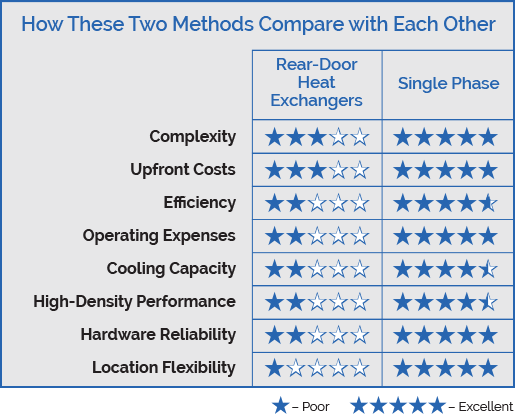
Matchup:
How These Competing Cooling Technologies Work
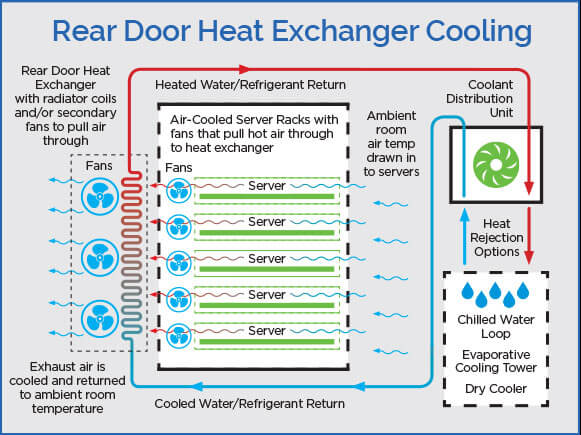
Rear Door Heat Exchanger (RDHx)
Originally designed to make air-cooling more efficient, RDHx systems were an early solution for bringing the cooling effects of a liquid-to-gas phase change closer to the heat source. With RDHx, radiator-like doors are attached to the fronts or backs of server racks. Heat produced by IT equipment is removed by air blown into the exchangers via fans. That heated air travels a short distance before transferring to water or refrigerant running inside the radiators.
Heated liquid is then carried away from the server rack to a cooling distribution unit (CDU), which in turn is connected to an outside chilled water system.
Some RDHx systems have “active doors” with integrated fans, while others rely solely on server fans to eject the air.
Essentially, RDHx is just a better form of air-cooling. Although often mistakenly considered so, it is not a liquid-cooling solution.
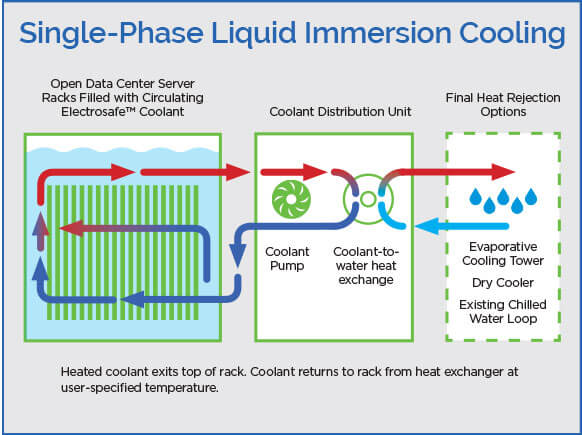
Single-Phase Immersion Cooling
With single-phase immersion cooling, servers are installed vertically in coolant bath of dielectric (electrically non-conductive) fluid. Like its two-phase counterpart, the coolant transfers heat through direct contact with server components. Heated coolant then exits the top of the rack and is circulated through a CDU connected to a warm-water loop. This loop incorporates a cooling tower or dry cooler on the other side as the final form of heat removal. In the end, cooled liquid is returned to the rack from a heat exchanger.
Single-phase immersion cooling systems are noted for their simplicity, which translates into greater upfront affordability, easier operations and less maintenance.

Compare, Contrast and Be Cool
Now let’s break down each of these technologies and see how they compare across eight important categories.
Complexity & Upfront Costs
RDHx
Absent the need for raised floors, air handlers and the like, RDHx is simpler than traditional air cooling. But since it still uses air as a medium of cooling, it requires compressor – or refrigerant-based cooling at the CDU level, or a chilled water loop. It also requires specialized building design and engineering such as CFD analysis to ensure appropriate layouts and cooling.
Further, environmental and humidity control systems are also needed. All these systems increase complexity and add costs. Although RDHx does not require raised floors, aisle containment, false ceilings, and plenums may still be needed.

On the plus side, operators will find it easy to add an RDHx to an air-cooled system, or to augment a liquid-to-chip solution attached solely to CPUs.
Single-Phase Immersion Cooling
In all fairness to competing systems, single-phase immersion cooling is arguably the simplest, most cost-effective way to cool a data center. For example, there are only three moving parts involved in GRC’s ICEraQ™ micro-modular immersion cooling solution.
As a result, we can confidently claim to reduce both data center CAPEX & OPEX by a full 50%, as we have for many of our customers.
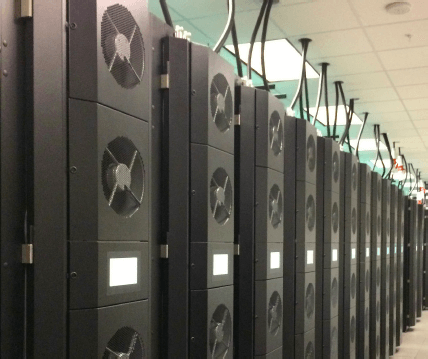
Rear Door Heat Exchanger Installation.
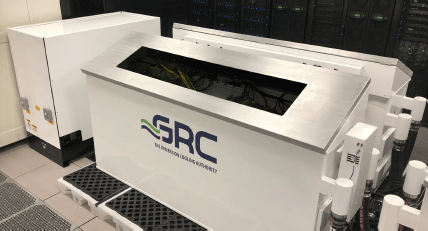
Immersion-cooled ICEraQ systems provide super easy server access.


Efficiency & Operating Expenses
RDHx
Again, because RDHx uses air – a bad conductor of heat, it requires a lot of air flow and a huge temperature delta between the incoming air and the heat source to maintain optimal core temperatures. The higher delta means that air must be cooled to temperatures that mandate the use of compressors or chiller plants to cool the air directly. Either way, when you consider the need for compressors plus the number of fans needed to create the required air flow, RDHx consumes significant amounts of energy
Plus, unlike immersion cooling, RDHx solutions still require server fans and do not reduce the server power consumption.
Given the combined electrical load of fans, chillers, CDUs and more,RDHx delivers a PUE of between 1.2 and 1.3.
It’s also important to note that, given tightening worldwide environmental regulations, many refrigerants are likely to get harder and costlier to acquire in the long run. This should definitely be considered when building a data center that requires compressor-based cooling.
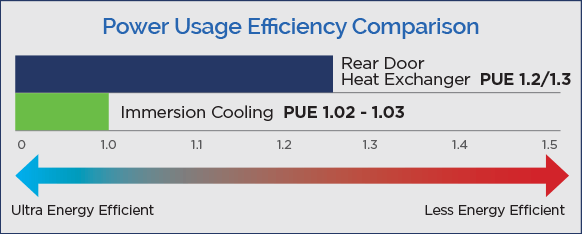
Single-Phase Immersion Cooling
With single-phase immersion cooling systems, 100% of the heat is picked up by the coolant. In addition, the coolant’s comparatively higher density and superior thermal conductivity means that it can maintain optimal core temperatures with a much lower delta between the coolant and the heat source.. This eliminates the need for compressor-based cooling, and reduces the amount of mechanical work/electrical power needed to create flow and run chiller plants.
Add the disabling or removal of server fans and a 10-30% reduction of server power is possible.
Consider as well that single-phase immersion cooling does not require all the ancillary equipment (and corresponding energy draw) associated with RDHx. As a result, it delivers a remarkable PUE of about 1.03, despite the reduction in server power.



Cooling Capacity & High-Density Performance
RDHx
RDHx systems can run either water or refrigerant. The former comes with major safety and reliability caveats to be discussed later. Although RDHx can be cost-competitive for 25-30 kW rack densities, there are limits to those benefits. In fact, its advantages drop sharply as densities rise beyond 15 kW per rack. Given the ever-increasing density of chips and hardware, operators may soon start to hit the 30 kW-per-rack wall with hardware refreshes.
Single-Phase Immersion Cooling
GRC ICEraQ and ICEtank systems can easily cool up to 100 kW per rack – theoretically up to 200 kW when used with a chilled water system. And while the financial case for GRC’s immersion cooling makes sense at rack densities as low as 10 kW (less in some cases), the higher capacity future-proofs the infrastructure against rising hardware density and the ever-evolving technology landscape.
Immersion cooling is also ideal for creating a diverse density layout. This allows operators to run high-density racks right next to lower density ones without stratification or the mixing of hot and cold air


Reliability & Location Flexibility
RDHx
RDHx does not score well in this category, and here’s why:
Feeding the radiator-like doors of RDHx systems are fluid lines containing either water or refrigerant. Depending on which – and whether they’re routed above or below critical IT equipment, leaks can be a major problem. There have actually been cases when failures have sprayed conductive water onto servers and ruined them. So, clearly, using water is a concern.
Yet using refrigerant can be a problem, too, but for different reasons. Aside from high costs, RDHx refrigerants also have a global warming potential (GWP),putting them under the constant scrutiny of the EPA and EEA. In fact, some formulations are in the process of being banned, causing more than a few operators to be concerned about supply disruptions.
Two other factors impede RDHx’s reliability and location flexibility. One is the fact that these systems – much like any other air-cooling system – expose IT assets to airborne contaminants, moisture, and increased levels of vibrations. Thus, they require additional systems and equipment to protect them from harsher environments.
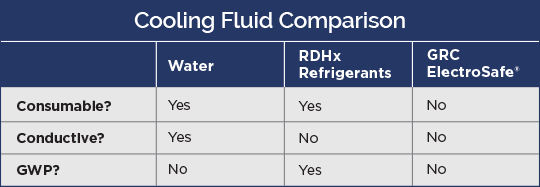
Next, RDHx still needs significant amounts of power and supporting infrastructure, which can limit location choices, especially for edge applications.
Single-Phase Immersion Cooling
In contrast to RDHx, single-phase immersion cooling scores an A+ when it comes to reliability and location flexibility. The reasons are simple. There are few moving parts (in other words, less things to go wrong). Also, servers are completely immersed, therefore shielded from any harmful environmental factors.
GRC ICEraQ and ICEtank™ systems are the epitome of simplicity, and can be placed virtually anywhere. In fact, our fully containerized ICEtanks can literally be deployed in a parking lot or loading dock.
Operators should also know that our ElectroSafe® coolant is non-conductive, totally inert, and planet-friendly. Most likely it will not need replacing over a typical data center lifecycle.



Conclusion: Single-Phase Immersion Cooling Finishes First
Because air-based systems are fast becoming an outmoded “legacy” method for cooling data centers – and since RDHx is essentially an enhanced form of air-cooling, it simply cannot match single-phase immersion cooling in the eight critical performance categories discussed here.
Ready to Grow Your Data Center? Let’s Talk!
Send us an email at info@www.grcooling.com or call us at +1.512.692.8003. A GRC associate will reach out and talk details with you. In the meantime, be sure to read Data Center Cold Wars — Part 1: Air-Based Cooling Versus Single-Phase Immersion Cooling and watch for the next installment.




